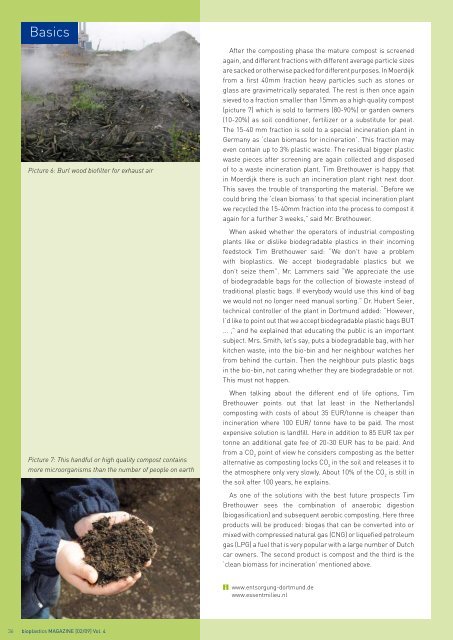bioplasticsMAGAZINE_0902
bioplasticsMAGAZINE_0902
bioplasticsMAGAZINE_0902
Create successful ePaper yourself
Turn your PDF publications into a flip-book with our unique Google optimized e-Paper software.
Basics<br />
Picture 6: Burl wood biofilter for exhaust air<br />
After the composting phase the mature compost is screened<br />
again, and different fractions with different average particle sizes<br />
are sacked or otherwise packed for different purposes. In Moerdijk<br />
from a first 40mm fraction heavy particles such as stones or<br />
glass are gravimetrically separated. The rest is then once again<br />
sieved to a fraction smaller than 15mm as a high quality compost<br />
(picture 7) which is sold to farmers (80-90%) or garden owners<br />
(10-20%) as soil conditioner, fertilizer or a substitute for peat.<br />
The 15-40 mm fraction is sold to a special incineration plant in<br />
Germany as ‘clean biomass for incineration’. This fraction may<br />
even contain up to 3% plastic waste. The residual bigger plastic<br />
waste pieces after screening are again collected and disposed<br />
of to a waste incineration plant. Tim Brethouwer is happy that<br />
in Moerdijk there is such an incineration plant right next door.<br />
This saves the trouble of transporting the material. “Before we<br />
could bring the ‘clean biomass’ to that special incineration plant<br />
we recycled the 15-40mm fraction into the process to compost it<br />
again for a further 3 weeks,” said Mr. Brethouwer.<br />
When asked whether the operators of industrial composting<br />
plants like or dislike biodegradable plastics in their incoming<br />
feedstock Tim Brethouwer said: “We don’t have a problem<br />
with bioplastics. We accept biodegradable plastics but we<br />
don’t seize them”. Mr. Lammers said “We appreciate the use<br />
of biodegradable bags for the collection of biowaste instead of<br />
traditional plastic bags. If everybody would use this kind of bag<br />
we would not no longer need manual sorting.” Dr. Hubert Seier,<br />
technical controller of the plant in Dortmund added: “However,<br />
I’d like to point out that we accept biodegradable plastic bags BUT<br />
... ,” and he explained that educating the public is an important<br />
subject. Mrs. Smith, let‘s say, puts a biodegradable bag, with her<br />
kitchen waste, into the bio-bin and her neighbour watches her<br />
from behind the curtain. Then the neighbour puts plastic bags<br />
in the bio-bin, not caring whether they are biodegradable or not.<br />
This must not happen.<br />
Picture 7: This handful or high quality compost contains<br />
more microorganisms than the number of people on earth<br />
When talking about the different end of life options, Tim<br />
Brethouwer points out that (at least in the Netherlands)<br />
composting with costs of about 35 EUR/tonne is cheaper than<br />
incineration where 100 EUR/ tonne have to be paid. The most<br />
expensive solution is landfill. Here in addition to 85 EUR tax per<br />
tonne an additional gate fee of 20-30 EUR has to be paid. And<br />
from a CO 2<br />
point of view he considers composting as the better<br />
alternative as composting locks CO 2<br />
in the soil and releases it to<br />
the atmosphere only very slowly. About 10% of the CO 2<br />
is still in<br />
the soil after 100 years, he explains.<br />
As one of the solutions with the best future prospects Tim<br />
Brethouwer sees the combination of anaerobic digestion<br />
(biogasification) and subsequent aerobic composting. Here three<br />
products will be produced: biogas that can be converted into or<br />
mixed with compressed natural gas (CNG) or liquefied petroleum<br />
gas (LPG) a fuel that is very popular with a large number of Dutch<br />
car owners. The second product is compost and the third is the<br />
‘clean biomass for incineration’ mentioned above.<br />
www.entsorgung-dortmund.de<br />
www.essentmilieu.nl<br />
36 bioplastics MAGAZINE [02/09] Vol. 4


















